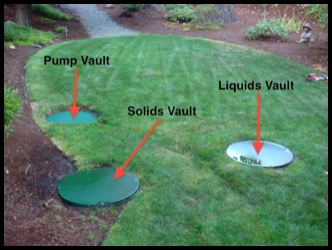
The first Vault we will talk about is the Solids Vault. No specific picture is provided here since there is no Homeowner performed maintenance required for this Vault. You system collects both liquids and solidsthen separate into one of two 1000 gallon vaults. Waste comes from your home and enters this Solids Vault. The Solids then settle to the bottom in this first tank and the liquids rise to the top. Once the liquids reach a certain level they move from the Solids Vault across to the Liquids Vault through a 4 inch pipe. Your STEP system is only capable of pumping LIQUIDS through the main STEP line into the City Sewer so this means the Solids Vault must be pumped just like a typical on premise septic system. Depending on the number of people in your household, a pumping service, (Hemley's, Northwest Cascade.....), should be called every 3 to 5 to years. Failure to maintain this can cause blockage, which could create a backup in your home. It is uncommon that the system would get to a blockage point before you become aware but, as with a typical septic system, this can occur.
___________________________________________________________________________________________________________________________________________________________________________________
LIQUIDS VAULT
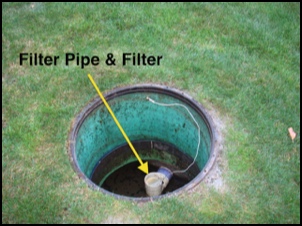
In the picture to the left you see the open liquids riser. The arrow points to the 4" filter pipe that houses the particle filter for your system. The pump that takes liquids from your system up to the STEP Mainline is not capable of handling anything but liquid therefore the liquids that pass into the Pump Vault must be filter so that nothing but liquid gets to the pump.
Looking closer at this picture you will also see a wire attached to the side of the riser with the other end of the wire hanging down to the filter pipe. To make filter removal easy the Homeowner put a lag bolt into the side of the riser then attached a wire to that bolt. The other end of the wire was then attached the to handle of the filter. When it is time to clean the filter the Homeowner removes the riser cap and pulls on the wire lifting the filter from the pipe.
Once the filter is removed use the hose to spray off any sediment from the inside and outside of the filter. After it is cleaned use the wire to lower the filter into place then a stick or pole to push it flush with the top of the filter pipe. Place the Riser cap back in place then tighten the 4 screws firmly. So that no water can enter the vault it is important that you get a firm seal when you tighten the screws. Be careful not to tighten too much as you can strip the screws. Periodically place the lid in a position that is absent of any screw holes. Over time the holes enlarge making it impossible to get Riser cap sealed.
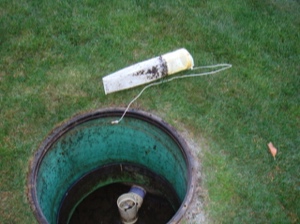
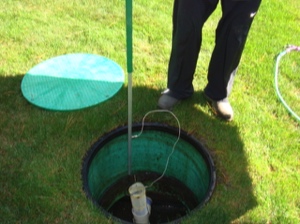
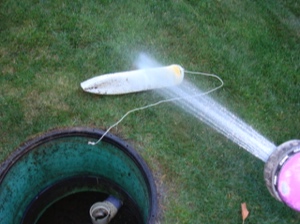
It’s very important that you clean this filter on a regular basis. If this filter gets clogged flow from your house can slow or even stop. If flow stops completely and the liquid vault fills it could back up into your house through the base of the toilets and bath tubes. If something like this happens check the filter before calling a service. Slow flowing sinks are a first alert. If one sink is slow then that sink is probably clogged. If multiple sinks are slow then there is a good chance that your filter is in need of cleaning.
___________________________________________________________________________________________________________________________________________________________________________________
PUMP VAULT
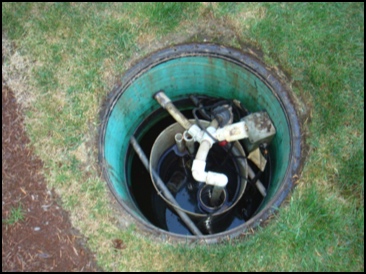
Also installed in this vault is a high liquid level Alarm Float. This float is set higher up in the vault that the Power Float. If the Power Float fails the liquids will continue to rise and eventually the Alarm Float rises. Just like the Power Float once the Alarm Float raises past parallel it trips a switch inside the float turning on your alarm. This alarm is alerting you to a problem that requires your attention. When this alarm sounds either your pump has failed, the power to the pump is off or the pump cannot keep up with the amount of liquid flowing into the vault. If the later is occurring then chances are you have ground water, rain water or irrigation water getting into you vaults. This needs to be resolved.
Some things to check if your alarm does sound:
-----CHECK your electrical panel to see if you have a tripped circuit breaker. Your pump should be on its own circuit so if that was the one tripped the alarm should stop once the pump catches up.
-----CHECK the side of your house that the vaults are on. Many homes have on off switches for the pump located on the side of the house. Check to see if those have somehow been turned off.
-----If you've checked all the power sources and everything is in working order then quiet the alarm. Depending on your alarm installation you may have a box with a red button on the outside of your house or you may have an alarm with a toggle switch inside your garage. Pushing the red button or moving the toggle switch to silent will silence the alarm. Don’t ignore the alarm. You should wait before silencing the alarm to make sure the pump isn’t working to catch up. If you push the button and silence the alarm that’s all you’ve done, silenced the alarm. The problem is still there.
Should your alarm sound during non business hours you can continue to use water in your home but it should be on a very limited use basis. Knowing this allows you to make an immediate service call but request morning service during normal business hours. Your specific situation will dictate your action here.
Note on community wide power outages: Several years ago we had a power outage that lasted for several days. If you were here then you know that during that this outage most continued to use water causing many vaults to fill beyond capacity. As soon as the power was restored your system alarm likely sounded along with most alarms in the neighborhood. This is normal. When power goes out our pumps stop but liquid flow may not. Its important to note that our STEP mainline is not sized for the volume of pumping that occurs in this situation. Because of this it could take hours for your system to pump down the liquids to a level that resets the alarm. Because of this we suggest careful use of water during the power outage but also for a several hour period following the restoration of power. This will give all systems a chance to catch up.
That's a tour of the STEP system installed on your property. Your home may not have risers installed so these pictures may be foreign to you. Even if you don't see risers like this you have the same setup, yours is simply buried under your landscaping. For easy access, and to seal out rain and irrigation water, risers should be installed.